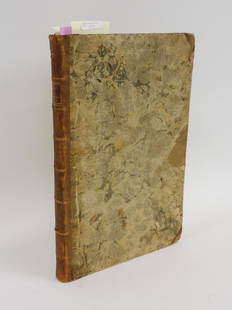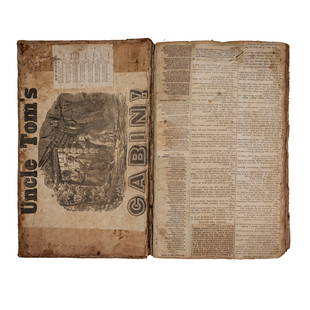
Matheson Letters, 1883-1886, "Bisbee Massacre" and Apache Attacks [178874]
Similar Sale History
View More Items in Ephemera
Related Ephemera
More Items in Ephemera
View MoreRecommended Books, Magazines & Papers
View More





![Matheson Letters, 1883-1886, "Bisbee Massacre" and Apache Attacks [178874]](https://p1.liveauctioneers.com/2699/324084/174414714_1_x.jpg?quality=1&version=1711485923&width=486)
![Matheson Letters, 1883-1886, "Bisbee Massacre" and Apache Attacks [178874]](https://p1.liveauctioneers.com/2699/324084/174414714_1_x.jpg?quality=80&version=1711485923)
Item Details
Description
The Robert Matheson Papers, Tombstone, Arizona Territory, 1883-1887 Fred N. Holabird, copyright 2024Twenty three hand written letters consisting of about 100 pages and several ephemeral pieces inclusive of postal covers tell an amazing first-person narrative of mining, the Apache wars with General Crook, and an outlaw holdup and subsequent hanging, now known as the [x=#8220/]Bisbee Massacre[x=#8221/] of which little has been previously written, particularly from a first person standpoint. The first person stories here offer an important first-hand glimpse into the storied [x=#8220/]wild west.[x=#8221/] The historical context and anecdotal information will follow.Robert Matheson, the AuthorRobert Matheson was a mining engineer, manager and mine owner who worked the mines of the southwestern desert region around the Mexico-US border and south into Mexico during the 1880[x=#8217/]s through at least 1898. These letters detail the most deadly years, involving an Apache mine massacre, the capture of Geronimo, and the [x=#8220/]Bisbee Massacre[x=#8221/] less than a year later. Matheson played a physical role in each of these events.Matheson was born in Scotland in 1859. He emigrated to California about 1880 and soon became a US citizen in Santa Clara County, where he met Maggie Newell and started a long term relationship. By 1882 he was off to the mines of southern Arizona. The reader and researcher are want for more background, but the letters leave the only clues. Once in Arizona, the letters [x=#8220/]back home[x=#8221/] to Maggie begin in January 1883, as Robert goes to work for one of the mines. His letters are mostly from Bisbee and Tombstone, reflecting the mining boom of the 1880s there. He does not mention the OK Corral, and it can be concluded he was not there during that event.While Matheson promises to come home to Santa Clara for Christmas in 1883, he never does. He resigned from a good producing mine as mine manager or foreman to prospect in Mexico. Reports of rich copper and gold deposits in Sonora were circulating throughout Tombstone and Bisbee, and Matheson was off. Thus began an incredible venture for the next few years.In Sonora, the Apache raided his mining camp, killing all seven of [x=#8220/]his men.[x=#8221/] He escaped with his life [x=#8211/] how, we[x=#8217/]ll never know. When he got back to Bisbee and Tombstone, the news had already reached there that they all had been killed. The towns [x=#8220/]rejoiced[x=#8221/] at the return of Matheson.That event was apparently the [x=#8220/]last straw[x=#8221/] for the Government, and General Crook was brought in to try to subdue the Apache. Matheson had apparently left about April 2 with a posse to [x=#8220/]avenge the deaths of his companions.[x=#8221/] Crook arrived and left about April 5th with a reported 200 Apache scouts and one cavalry unit. Matheson met up with them and joined the new group in pursuit of the Apache.Matheson, with Crook[x=#8217/]s company, caught the Apache and [x=#8220/]Taught them a lesson they will never soon forget.[x=#8221/] Since he is writing his girlfriend, the details are left out, as they are in anecdotal historical accounts. What we do know from historical accounts is that Crook captured several chiefs. They, and others agreed to come to the San Carlos Reservation. Geronimo, the leader, whose name was not known to the men of the posse at this time, escaped, only to reign terror for some time to come, continually discussed in the letters without ever using Geronimo[x=#8217/]s name. Matheson had many friends in Bisbee and Tombstone. As a mining man, one of his best friends was John C. Tappenir, a local assayer in Bisbee. The two were as close as [x=#8220/]brothers.[x=#8221/]Matheson spent the next few months working his mine in Sonora and apparently working for the Silver Bear Mining Company in Bisbee and alternately (?) with his mining property in Sonora. He resigned his managerial post with the Silver Bear in early November. The letters do not reflect the Sonora mine name, and Matheson is clearly a true-blue mining man [x=#8211/] not a man of mining promotion or stock promoter, thus news of his Sonora exploits are not found in the press, as was typical at the time. Matheson was mining metal. His letters do reflect the need for outside investment, but the methods used for looking for that investment are never discussed. He remarked several times that he hoped to sell the mine, but the Apache [x=#8220/]depredations and murders[x=#8221/] kept potential investors away.In late November, 1883, Matheson returned to Bisbee to find his best friend Tappenir [x=#8220/]Cold dead and in the ground,[x=#8221/] a victim of [x=#8220/]brutal, cowardly murder.[x=#8221/] Six men had planned to rob a store that had the payroll for the Copper Queen mine. One evening at just after 5pm, five of the outlaws raided a store, robbed it and the owner of his gold watch and cash, and killed five people while exiting. The actual account of shooting their way out of town reads just like a movie, but its real. Tappenir, who worked a few doors away, came outside and was shot immediately. They ruthlessly killed every person they saw, including a pregnant woman. Literally, off they rode into the sunset.A posse formed immediately and began in chase. It was joined by a man named Heath, who along the way tried to convince the posse to go another way, that the robbers went in a different direction than their scout thought. After splitting up, the main group caught up with at least one of them. Matheson, who had come back to Bisbee after the first posse left, joined the second posse, livid at the idea his best friend had been murdered. That second posse went into Mexico, possibly led by Matheson, who by this time was truly an expert at the Sonora trail. They caught two of the robbers and brought them back to Bisbee. The other robbers stopped at a ranch, and the rancher remembered them stopping before, discussing plans to rob a store. He had no idea it had actually occurred. But when he found out, he notified the Marshal, and identified the leader as Heath, the very man who had misled the first posse.All six were caught. Heath insisted on a separate trial. Matheson discusses all this and the resultant hanging, presenting his inscribed [x=#8220/]ticket[x=#8221/] to the hanging to Maggie, present in this archive. All of that activity took place between the fall and winter of 1883-1884, hence Matheson not making it back to Santa Clara. Meanwhile, Matheson[x=#8217/]s family appears a bit estranged, and interferes with his relationship with Maggie, telling her to move on and [x=#8220/]forget Robert.[x=#8221/] The letters form a very personal and intelligent discussion of feelings, love and life.Matheson returns to Sonora to work on his mine. No details are offered. He is gone months, sometimes back and forth because of Apache attacks. In 1885 he spends voluminous pages discussing life in Arizona in a most wonderful description of the people, places and habits of this remote [x=#8220/]God-forsaken[x=#8221/] region.He was hired [x=#8220/]by an English company[x=#8221/] to go to South America, which he apparently did, though no letters remain discussing it.In 1886, Maggie meets another man and breaks it off with Matheson. Interestingly, her letters continue to some degree, a most welcome surprise. The last letters reflect Matheson working at one of the mines at San Xavier, where he clearly spent in excess of a year.Research indicates that in the 1890s Matheson worked in a remote mining district further west in what is today Imperial County known as Cargo Muchacho. He was based in San Diego. Little is known of his life after this period, as Matheson was not a man of the press. It appears he may have married early in the 1900s in Los Angeles (still listed as a [x=#8220/]miner[x=#8221/]), and perhaps had a son of the same name, who ran away from home at age 7, and was caught. An apparent divorce shortly followed. The name Robert Matheson becomes more common in western research after 1900, clouding matters considerably.The events that are the subject of the letters are not well documented in a first hand way. This archive sheds new light on the Apache raids of General Crook[x=#8217/]s time and the [x=#8220/]Bisbee Massacre.[x=#8221/]Full transcriptions of the letters accompany the lot. They are not printed in the catalog to maintain the rarity and importance of this preciously unknown archive. Bisbee Arizona Robert Coelln Collection
Buyer's Premium
- 25%
Matheson Letters, 1883-1886, "Bisbee Massacre" and Apache Attacks [178874]
Estimate $5,000 - $15,000
7 bidders are watching this item.
Shipping & Pickup Options
Item located in Reno, NV, usOffers In-House Shipping
Local Pickup Available
Payment
Accepts seamless payments through LiveAuctioneers

Related Searches
TOP






















![[ENTERTAINERS]. A group of letters, photographs, and ephemera signed: 9 signed items, condition: [ENTERTAINERS]. A group of 13 letters, photographs, and ephemera signed, comprising; HITCHCOCK, Alfred (1899-1980). Self-portrait signed ("Hitch"). Framed. -- ROBESON, Paul (1898-1976). Paul Ro](https://p1.liveauctioneers.com/197/243560/126320500_1_x.jpg?height=310&quality=70&version=1649297800)






















































